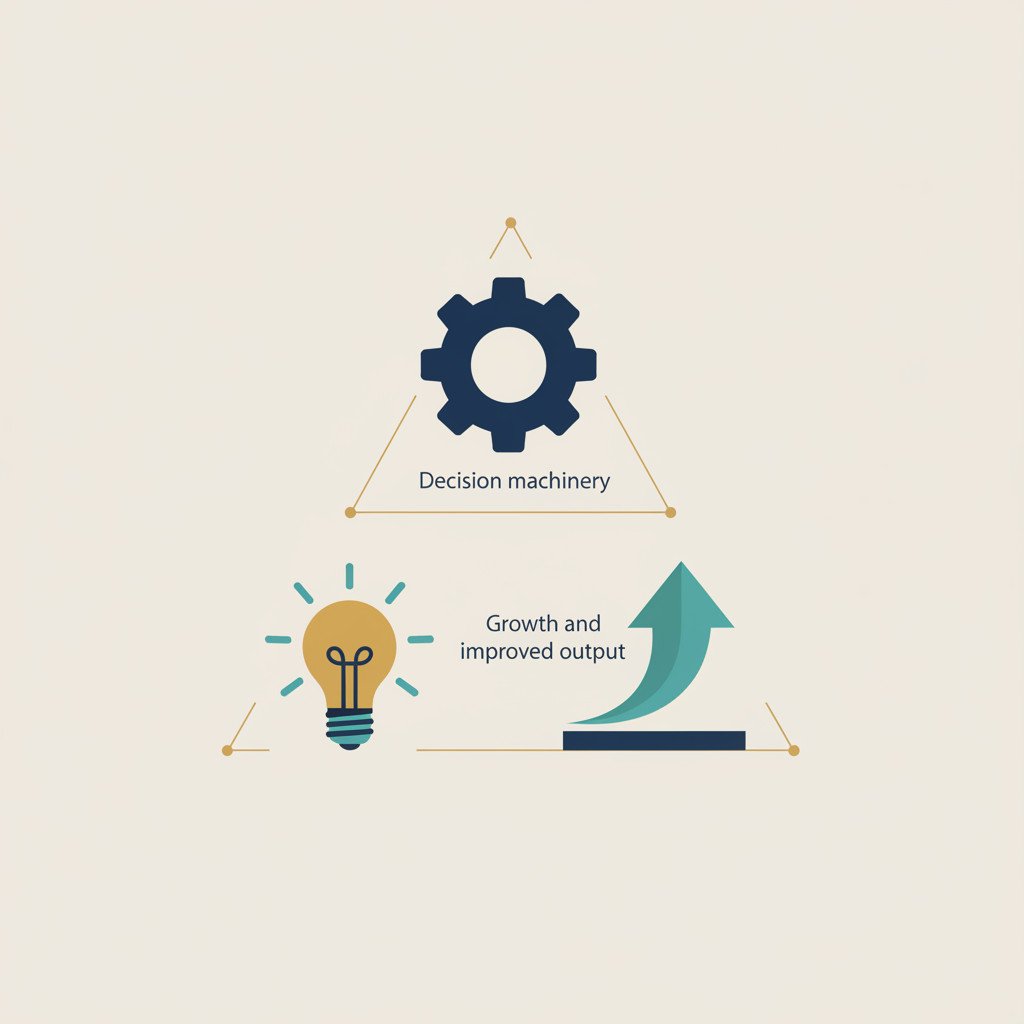AI success formula for executives
Executives who master the AI success formula for executives turn technology into measurable business growth. They face thousands of decisions each day, and AI can make those decisions more accurate. Because decision quality multiplies resource performance, small accuracy gains can lift output significantly. Therefore, leaders must focus on practical use cases like pricing, automation, and real-time rebalancing.
This article offers a pragmatic playbook that links AI work directly to margin and throughput. It explains how to raise decision accuracy, increase activity rate, and get more from fixed resources. Moreover, you will find short experiments and clear metrics you can run inside a quarter. “If output equals decision accuracy multiplied by resource performance, then the role of AI becomes clear: it’s a technology that can be used to optimize each part of that equation.” Read on to learn concrete steps and priority checks to start delivering that value this quarter. Start now.

AI success formula for executives: key insights and practical rules
Executives must treat AI as an amplifier for judgment and execution. Because decisions multiply resource performance, AI should focus on three levers. These are decision accuracy, activity rate, and resource performance. Each lever links directly to output and margin improvement.
Key insights
- Prioritize high impact decisions first. Start by mapping the 5 percent of decisions that require active attention. Then, target the highest value choices with models and data. This improves decision accuracy and reduces costly errors.
- Optimize decision accuracy with simple experiments. Use small holdout tests and lift measures. As a result, you learn fast and avoid large rollouts that fail. Remember the rule: if output equals decision accuracy times resource performance, accuracy drives leverage.
- Raise activity rate through targeted automation. Automate repetitive workflows to shorten cycles and increase frequency. Consequently, you increase throughput while freeing human time for strategic work. Tools from UiPath show proven gains in cycle time and consistency.
- Improve resource performance with real time rebalancing. For example, optimize pricing, inventory, and staffing with models that react to demand. Therefore, you get more value from fixed and variable resources without big capital expenditure.
- Use clear success metrics. Define decision lift, time to act, and resource utilization. Then, track these metrics weekly. Because teams need fast feedback, short metrics windows beat annual reviews.
Evidence and expert views
- The framework rests on a simple fact: output equals the interaction of decisions and resources. As a result, leaders should evaluate AI opportunities by their likely impact on accuracy, activity, or performance. This view echoes many executive playbooks and research How do executives boost decision accuracy?.
- Many case studies show pricing optimization and automation deliver measurable ROI. For more on ROI and pricing examples, read this practical guide How does the Executive AI success formula translate to real ROI?.
Practical steps to start this quarter
- Run a decision inventory in two weeks. Identify 20 decisions that affect revenue or cost.
- Run three micro experiments to measure lift. Use holdouts and control groups.
- Automate one repetitive process to raise activity rate and free capacity.
For tactical playbooks and step by step guides, see this companion article What steps unlock the executive formula to AI success?.
Related keywords: decision accuracy, resource performance, activity rate, automation, pricing optimization, real time optimization, output.
AI success formula for executives: the executive strategic role
AI is not a plugin. Executives lead strategy, priorities, and governance. Because AI changes how decisions are made, leaders must own outcomes. Therefore, they translate high level goals into decision level metrics and tests.
Key roles and strategies
- Sponsor measurable pilots. Provide resources and remove blockers so teams run fast experiments.
- Define decision metrics. Focus on decision accuracy, activity rate, and resource performance to link AI to output.
- Map the decision inventory. Identify 20 decisions that drive revenue or cost, then rank by value.
- Prioritize use cases. Choose high impact work such as pricing, automation, and real time rebalancing.
- Set guardrails and governance. Ensure data privacy, model explainability, and secure client infrastructure.
- Build cross functional teams. Combine product, ops, data science, and domain experts for faster learning.
- Invest in tooling and integration. Deploy full stack brand trained AI workers for repeatable tasks.
- Measure and iterate weekly. Because short feedback cycles beat annual reviews, adjust fast and scale winners.
- Shift culture toward test and learn. Reward validated lifts, not just deployment.
In short, executives must act as chief architects of AI programs. They set the north star, fund experiments, and demand measurable lift. As a result, organizations convert AI into predictable growth.

Evidence table: AI success formula for executives — AI tools for executives and AI-driven growth systems
This table compares AI tools and solutions that support the AI success formula for executives. It highlights how each tool improves decision accuracy, activity rate, or resource performance. Use this comparison to pick pilots that deliver measurable lift. Below, tools include EMP0 platforms and complementary enterprise solutions.
| Tool Name | Primary Function | Unique Features | Benefits for Executives |
|---|---|---|---|
| EMP0 Content Engine | Automated content generation and personalization | Brand-trained models, multi-channel templates, SEO optimization | Speeds marketing output, improves lead quality, and reduces content cost |
| EMP0 Marketing Funnel | Orchestrates campaigns and lead flows | Closed-loop analytics, automated segment journeys, conversion tuning | Raises conversion, centralizes campaign metrics, enables marketing automation |
| EMP0 Sales Automation | Automates outreach, scoring, and follow-ups | Custom playbooks, CRM integration, activity orchestration | Increases activity rate, scales qualification, improves win rates |
| EMP0 Retargeting Bot | Real-time cross-channel re-engagement | Behavioral triggers, dynamic creatives, personalization engine | Recovers lost users, boosts conversions, increases LTV |
| EMP0 Revenue Predictions | Revenue and pricing forecasts | Probabilistic forecasting, scenario analysis, pricing signals | Improves decision accuracy, guides resource allocation and pricing |
| UiPath | Enterprise robotic process automation | Extensive connectors, attended and unattended bots, governance | Automates manual workflows, shortens cycle time, reduces errors |
| Peak AI | Real-time optimization and forecasting | Demand sensing, inventory and pricing optimization | Enables real-time resource rebalancing and pricing lift |
Related keywords: AI success formula for executives, AI tools for executives, AI-driven growth systems. Choose tools that map to your highest value decisions and then run short tests to prove lift.
Payoff: how the AI success formula for executives drives revenue and efficiency
Adopting the AI success formula for executives turns experiments into predictable results. Executives who act deliberately see revenue lift and lower cost quickly. Because AI sharpens decision accuracy and raises activity rate, small changes compound rapidly. The result feels transformative rather than incremental.
Imagine pricing models that capture hidden margin in minutes. Or automation that frees teams to focus on high value work. In both cases, AI multiplies what you already own. Leaders report faster cycles, clearer forecasts, and less firefighting.
Concrete outcomes you can expect
- Revenue growth and margin expansion. Better pricing and targeting capture more willingness to pay.
- Faster time to market. Automation shortens cycles and accelerates experiments.
- Higher utilization of people and assets. Real time rebalancing reduces idle capacity.
- Reduced operating cost. Bots eliminate repetitive work and human error.
- Improved forecasting and planning. Probabilistic models lower surprise and improve cash flow.
Vivid examples
- Retailer scenario: Dynamic pricing increased conversion by six percent. Inventory turnover improved and markdowns fell. Consequently, gross margins rose materially.
- SaaS scenario: Sales automation increased rep touchpoints by forty percent. Pipeline quality rose and win rates improved. Revenue per rep climbed without hiring.
- Manufacturing scenario: Predictive rebalancing cut downtime and lifted output without capex.
How to capture the payoff
Start with one high value decision. Then, run a short controlled experiment. Measure decision lift and activity rate. If you see positive lift, scale that use case while protecting data and governance.
In short, the payoff is real and repeatable. When executives tie AI to decision accuracy and resource performance, AI becomes a reliable growth engine.
Conclusion
The AI success formula for executives is a practical roadmap. It links decision accuracy, activity rate, and resource performance to measurable business value. When leaders focus on these levers, AI stops being experimental and becomes predictable growth machinery.
EMP0 stands ready to accelerate that journey. As Employee Number Zero, LLC, EMP0 delivers full stack, brand trained AI workers and AI powered growth systems. Their solutions include Content Engine, Marketing Funnel, and Sales Automation. These tools work inside secure client infrastructure. Therefore, teams retain data control while scaling execution.
Use EMP0 to run fast, measurable pilots. Start with one high value decision. Then, test pricing, automation, or real time rebalancing. EMP0’s systems produce clear metrics, so you prove lift before you scale. As a result, you increase revenue, cut waste, and free people for strategic work.
Explore EMP0’s resources and case studies to plan your first pilot. Visit the website emp0.com and the blog articles.emp0.com for guides. For workflow integrations, see n8n.io/creators/jay-emp0. Follow the team on Twitter/X @Emp0_com to keep up with updates. Start small, measure lift, and scale what works. Your next quarter can deliver real, AI driven results.
How quickly can I expect ROI from the AI success formula for executives?
Expect impact in weeks, not years. Run a focused pilot for six to twelve weeks. Measure decision lift, activity rate, and resource performance. Because short experiments reduce risk, you learn fast and avoid costly rollouts. If a pilot shows positive lift, therefore scale gradually. Use holdouts and control groups to prove causal impact.
What are the main security and governance concerns, and how do I mitigate them?
Data privacy and model explainability are top concerns. Use secure client infrastructure and role based access. For example, isolate production data, log model decisions, and run periodic audits. Additionally, require explainability for high risk decisions. As a result, you lower regulatory and operational risk.
Which decisions should executives prioritize for AI driven growth systems?
Start with high value, repeatable decisions. Priorities include:
- Pricing and promotions to improve decision accuracy
- Lead scoring and sales automation to raise activity rate
- Inventory and staffing to boost resource performance
- Marketing targeting and retargeting to increase conversion
Choose the top three decisions that affect revenue or cost and test quickly.
How should leaders measure success and scale AI programs?
Define simple, tied metrics. Track decision lift, revenue per decision, conversion lift, activity rate, and utilization. Measure weekly to iterate fast. Then, scale winners with cross functional teams, guardrails, and automated monitoring. In short, tie every AI use case to a clear business metric and prove lift before broad rollout.

